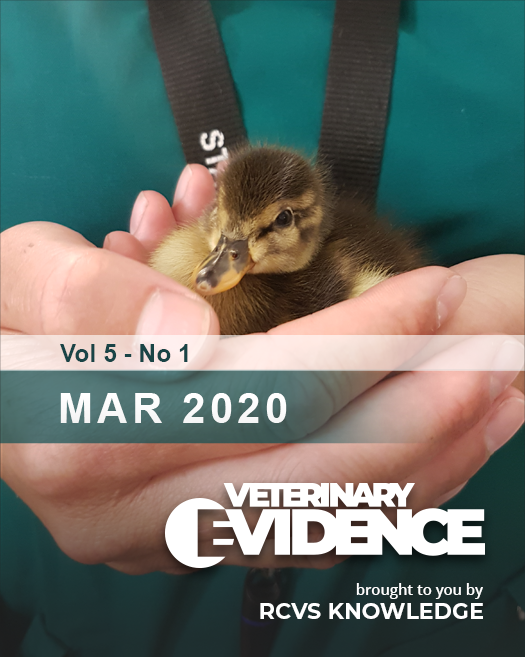DOI
https://doi.org/10.18849/ve.v5i1.218Abstract
PICO question
In calves <14 days old which are moderately to severely dehydrated (5–9%) or acidaemic (base excess -5 to -15 mM), does intraperitoneal fluid therapy result in comparable or superior clinical improvement when compared to intravenous fluid therapy?
Clinical bottom line
Category of research question
Treatment
The number and type of study designs reviewed
Two papers were critically reviewed (one randomised clinical trial and one case series)
Strength of evidence
Weak evidence relevant to the topic question
Outcomes reported
Statistically significant differences were not found between treatment groups (administration of intravenous fluids [n = 27] or intra-peritoneal fluids [n = 28]) in the clinical trial, and findings relevant to the topic question were not reported in the case series of 18 calves
Conclusion
These studies provide insufficient evidence that intraperitoneal (IP) fluid is comparable to, or provides superior clinical improvement, when compared to intravenous (IV) fluid therapy in moderately to severely dehydrated (5–9 %) or acidaemic calves (base excess -5 to -15 mM) aged < 14 days of age
How to apply this evidence in practice
The application of evidence into practice should take into account multiple factors, not limited to: individual clinical expertise, patient’s circumstances and owners’ values, country, location or clinic where you work, the individual case in front of you, the availability of therapies and resources.
Knowledge Summaries are a resource to help reinforce or inform decision making. They do not override the responsibility or judgement of the practitioner to do what is best for the animal in their care.
![]()
![]()
References
Constable, P. (2003). Fluid and electrolyte therapy in ruminants. Veterinary Clinics of North America: Food Animal Practice, 19(3), 557–597. DOI: http://dx.doi.org/10.1016/S0749-0720(03)00054-9
Dickson, L. (1987). Fluid therapy in cattle. Proceedings of the 4th Seminar of the Dairy Cattle Society of the New Zealand Veterinary Association held at Rotorua, New Zealand, 18–20 November 1987, 85–89.
Edwards, A. J. & Williams, L. L. (1972). Fluid therapy in treating dehydration from calf scours (a practical approach). Veterinary Medicine, Small Animal Clinician, 67(3), 273–277.
González-Montaña, J. R., Martin, M. J. & Alonso, P. (2017). General aspect and current fluid therapy in cattle with digestive diseases. American Journal of Animal and Veterinary Sciences, 12(3), 111–131. DOI: http://dx.doi.org/10.3844/ajavsp.2017.111.131
Koenig, G. J., Holmberg, C. A., Medeiros, R. L. & Guterbock, W. M. (1995). Comparison between intraperitoneal and intravenous fluid administration in moderately dehydrated calves on a California calf ranch. Proceedings of the Twenty Seventh Annual Convention American Association of Bovine Practitioners, Pittsburgh, Pennsylvania, USA, September 22–25, 1994, 199–200.
Lewis, L. D. & Phillips, R. W. (1971). Diarrhea in the calf. Part II: Secondary changes and treatment. Proceedings of the American Association of Bovine Practitioners, 109–114.
McSherry, B. J. & Grinyer, I. (1954). Disturbances in acid-base balance and electrolyte in calf diarrhea and their treatment. A report of eighteen cases. American Journal of Veterinary Research, 15(57), 535–541.
Michell, A. R. (1988). Drips, drinks and drenches: what matters in fluid therapy. Irish Veterinary Journal, 42, 17–22.
Phillips, R. W. (1985). Fluid therapy for diarrheic calves. What, how, and how much. The Veterinary Clinics of North America: Food Animal Practice, 1(3), 541–562. DOI: https://doi.org/10.1016/S0749-0720(15)31302-5
Radostits, O. M. (1965). Fluid therapy in calf diarrhea. The Canadian Veterinary Journal. 6(7), 180.
Roussel, A. J. (1983). Principles and Mechanics of Fluid Therapy in Calves. Compendium on Continuing Education for the Practicing Veterinarian, 5(6), S332–S336.
Vermunt, J. J. (1994). Rearing and management of diarrhoea in calves to weaning. Australian Veterinary Journal, 71(2), 33–41. DOI: https://doi.org/10.1111/j.1751-0813.1994.tb06149.x
Watt, J. G. (1967). Fluid therapy for dehydration in calves. Journal of the American Veterinary Medical Association, 150(7), 742–750.
License
Copyright (c) 2020 Allan John Gunn

This work is licensed under a Creative Commons Attribution 4.0 International License.
Veterinary Evidence uses the Creative Commons copyright Creative Commons Attribution 4.0 International License. That means users are free to copy and redistribute the material in any medium or format. Remix, transform, and build upon the material for any purpose, even commercially - with the appropriate citation.
